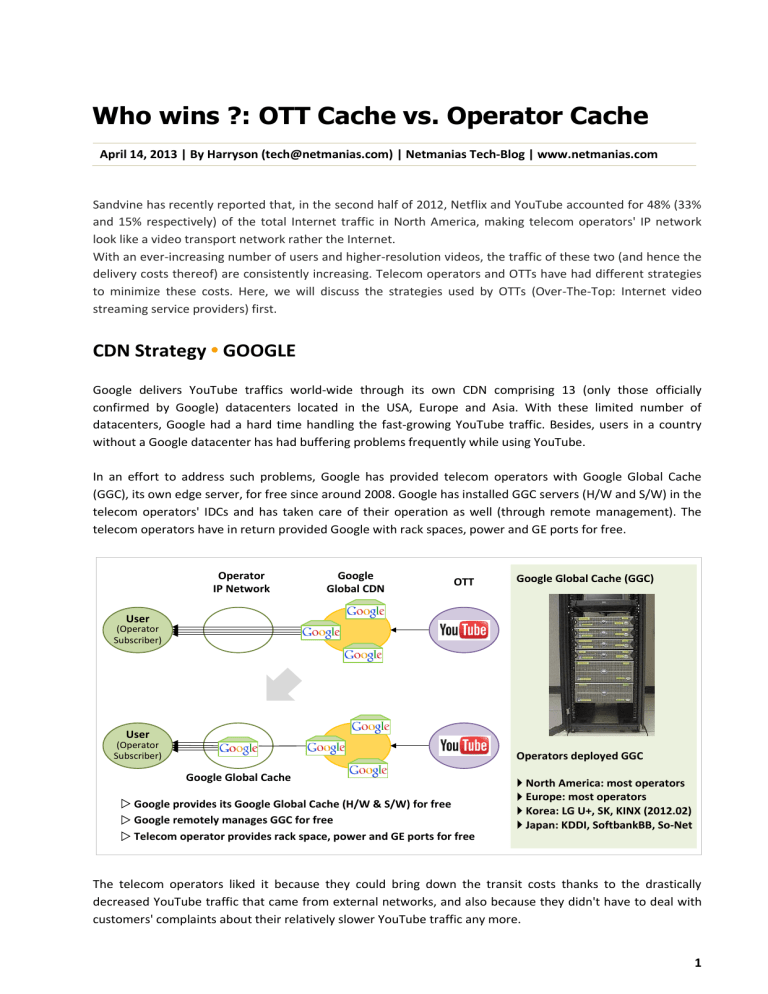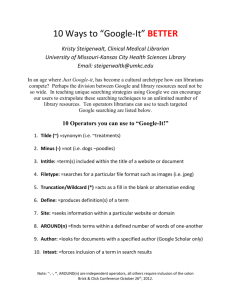
Who wins ?: OTT Cache vs. Operator Cache
April 14, 2013 | By Harryson (tech@netmanias.com) | Netmanias Tech-Blog | www.netmanias.com
Sandvine has recently reported that, in the second half of 2012, Netflix and YouTube accounted for 48% (33%
and 15% respectively) of the total Internet traffic in North America, making telecom operators' IP network
look like a video transport network rather the Internet.
With an ever-increasing number of users and higher-resolution videos, the traffic of these two (and hence the
delivery costs thereof) are consistently increasing. Telecom operators and OTTs have had different strategies
to minimize these costs. Here, we will discuss the strategies used by OTTs (Over-The-Top: Internet video
streaming service providers) first.
CDN Strategy • GOOGLE
Google delivers YouTube traffics world-wide through its own CDN comprising 13 (only those officially
confirmed by Google) datacenters located in the USA, Europe and Asia. With these limited number of
datacenters, Google had a hard time handling the fast-growing YouTube traffic. Besides, users in a country
without a Google datacenter has had buffering problems frequently while using YouTube.
In an effort to address such problems, Google has provided telecom operators with Google Global Cache
(GGC), its own edge server, for free since around 2008. Google has installed GGC servers (H/W and S/W) in the
telecom operators' IDCs and has taken care of their operation as well (through remote management). The
telecom operators have in return provided Google with rack spaces, power and GE ports for free.
Operator
IP Network
Google
Global CDN
OTT
Google Global Cache (GGC)
User
(Operator
Subscriber)
User
(Operator
Subscriber)
Operators deployed GGC
Google Global Cache
w Google provides its Google Global Cache (H/W & S/W) for free
w Google remotely manages GGC for free
w Telecom operator provides rack space, power and GE ports for free
} North America: most operators
} Europe: most operators
} Korea: LG U+, SK, KINX (2012.02)
} Japan: KDDI, SoftbankBB, So-Net
The telecom operators liked it because they could bring down the transit costs thanks to the drastically
decreased YouTube traffic that came from external networks, and also because they didn't have to deal with
customers' complaints about their relatively slower YouTube traffic any more.
1
Also, Google liked it because it could provide YouTube users with improved QoE and higher-resolution video
services without burden of IDC fees. Since such strategy by Google was beneficial to both of them (Google
itself and telecom operators), neither of them needed to pay. GGCs have already been used by most telecom
operators in North America and Europe, and by SK, LG U+ and KINX in Korea in February 2012.
Google, with the fascinating content that YouTube has, has successfully expanded its CDN throughout the
world, even into the networks of telecom operators, without paying a single penny.
Users
Operator IP Network
Transit/IX
Global CDN
OTT
L Operator: increased backbone cost
L Google: hard to deliver high resolution video without
Higher costs for transit and IP backbones due to YouTube traffic
buffering
Due to long RTT between its datacenter and users
L Operator: more complaints from its Internet subscribers
about buffering
Google
Datacenter
Google
Global CDN
Transit/IX
IP Edge
IP Backbone
Google
Datacenter
Operator
Datacenter
Google
Cache
Google
Global CDN
Transit/IX
IP Edge
IP Backbone
J Operator: reduced transit costs
J Operator: no costs for building or operating caching
solution (operator CDN or transparent cache)
J Google: improved YouTube video QoE for its user
YouTube traffic delivered from GGCs in the network of
operators, providing low RTT
J Google: expanded its CDN throughout the world,
J Operator: improved YouTube QoE for its Internet subscriber even into the networks of telecom operators at no IDC
cost
2
CDN Strategy • NETFLIX
Netflix, with over 30 million paid subscribers generating 33% of the Internet traffic in North America, applies
the same strategy as Google's as to be seen below. To serve its customers, Netflix uses fee-based CDN services
provided by Akamai, Limelight and Level3. Obviously, Netflix hasn't been happy with the CDN service fees it
has been paying to CDN providers. But, what was worse is that it has to pay even more to provide higherresolution video services (full HD level) in order to be able to attract more subscribers.
And Netflix noticed Google, once in a similar situation, had managed to have its GGCs deployed in telecom
operators' network somehow. That's when Netflix, also well-equipped with all the coolest content, decided to
apply the same strategy. And as a result, Netflix Cache was first introduced in June 2012.
Content service fee
Operator
IP Network
User
Netflix Cache
Global CDN
OTT
CDN fee
Akamai/
Limelight
(Operator
Subscriber)
Content service fee
Operator
IP Network
User
(Operator
Subscriber)
Netflix Cache
w Netflix provides its Netflix Cache (H/W & S/W) for free
w Netflix remotely manages servers for free
w Telecom operator provides rack space, power and GE ports for free
Telecom operators deployed
Netflix Caches as of Jan. 2013
} North America:
Cablevision (US), Clearwire
(US), Google Fiber (US),
Telus (Canada)
} Europe:
British Telecom (UK), Virgin
Media (UK), TDC (Denmark)
} Latin America:
Telmex, GVT
Just like GGC, Netflix Cache was developed, offered for telecom operators' uses at no charge, and operated by
Netflix, an OTT. Again, the telecom operators have supplied rack spaces, power and GE ports in their IDCs to
Netflix at no charge.
Currently, Netflix Cache has been deployed inside the network of telecom operators like Cablevision, Google
Fiber and Clearwire in the USA, Telus in Canada, BT and Virgin Media in the UK, TDC in Denmark, and Telmex
and GVT in Central America (countries where Netflix service is available). Especially in Europe, all the Netflix
traffic is now delivered to Netflix users through Netflix Cache, not through global CDNs.
3
Users
Global CDN
Public Internet
Operator IP Network
OTT
L Operator: increased transit costs
L Netflix: CDN cost
Higher costs for transit and IP backbones due
to Netflix traffic
CDN services currently provided by Akamai, Limelight and Level3
L Netflix: hard to deliver high resolution video without buffering
Average resolution in US – 2~3 Mbps
Operator
Datacenter
Akamai
Edge
IP Edge
Akamai Global CDN
Limelight
Datacenter
IP Backbone
Transit/IX
Limelight Global CDN
Operator
Datacenter
Netflix
Cache
IP Edge
IP Backbone
NB/eNB
Operator
Datacenter
Public Internet
Netflix
Cache
J Operator: reduced transit costs
J Operator: no costs for building or operating caching
solution (operator CDN or transparent cache)
J Netflix: improved Netflix video QoE for its user
YouTube traffic delivered from IP edge of operator IP
network, providing low RTT
Netflix: expanded its CDN throughout the world, even
J Operator: improved Netflix QoE for its Internet subscriber J
into the networks of telecom operators at no IDC cost
Neflix started full HD services (1920x1080, 5~7 Mbps) and 3D video services (12 mbps) in January 2013. Netflix
subscribers now can enjoy high resolution services at no extra charge. But, here the tricky thing is that these
high resolution services are only available to subscribers of the telecom operators who have Netflix Cache
placed in their network. Such restrictions are intended specifically to promote telecom operators' deployment
of Netflix Cache, thereby bringing down CDN costs and providing high-resolution services without paying IDC
fees to telecom operators.
When this service came up, Time Warner Cable protested that the full HD and 3D services should also be
4
available to the subscribers of telecom operators how have not deployed a Netflix Cache. What has long been
an issue was the network neutrality of telecom operators. But now, an issue of the neutrality of content that
OTTs should not discriminate among telecom operators in providing their contents has been raised.
I
Now it's not telecom operators, but OTTs who hold all the cards.
Anyway, it turned out Netflix could have more CDNs deployed across the networks of telecom operators in the
world without any cost just like Google did. YouTube and Netflix, the two top OTTs, have found a way to have
their Cache getting inside the network of telecom operators throughout the world by taking advantage of
their powerful content and huge user base. The market of telecom operator CDN and transparent Cache was
once formed to reduce network costs through caching OTTs' traffic in the network of telecom operators and
generate new profit sources. However, the market is now at risk of being significantly reduced.
Telecom operators' CDNs and Transparent Cache are developed by domestic or foreign vendors and provided
to telecom operators. So, the vendors may make some profits out of it. The telecom operators may also build
CDN in their network and collect CDN service fees from OTTs. However, if YouTube and Netflix have their own
Cache inside the network of telecom operators, no one except for OTTs can earn a penny.
5
LTE Identification I: UE and ME Identifier
Netmanias Research and Consulting Scope
99
00
01
02
03
04
05
06
07
08
09
10
11
12
13
eMBMS/Mobile IPTV
CDN/Mobile CDN
Transparent Caching
BSS/OSS
Services
Cable TPS
Voice/Video Quality
IMS
Policy Control/PCRF
IPTV/TPS
LTE
Mobile
Network
Mobile WiMAX
Carrier WiFi
LTE Backaul
Data Center Migration
Carrier Ethernet
FTTH
Wireline
Network
Data Center
Metro Ethernet
MPLS
IP Routing
Visit http://www.netmanias.com to view and download more technical documents.
About NMC Consulting Group (www.netmanias.com)
NMC Consulting Group is an advanced and professional network consulting company, specializing in IP network areas (e.g., FTTH, Metro Ethernet and IP/MPLS), service
areas (e.g., IPTV, IMS and CDN), and wireless network areas (e.g., Mobile WiMAX, LTE and Wi-Fi) since 2002.
Copyright © 2002-2013 NMC Consulting Group. All rights reserved.
6

